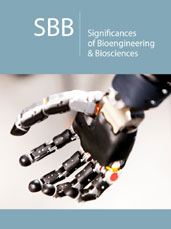- Submissions

Abstract
Significances of Bioengineering & Biosciences
Application of Transcranial Magnetic Stimulation in Urological Surgery: From Neuromodulation to Pelvic Floor Functional Reconstruction
Nan Wang1#, Shaohui Jiang2#, Yunwei Zhang3, Yawen Song4, Hong Chen5, Feilin Wang6 and Jingyu Li2*
1Department of Neuroelectrophysiology, Dandong Central Hospital, China
1Department of Urology, Dandong Central Hospital, China
1Postpartum Rehabilitation Center, Shenyang Women’s and Children’s Hospital, China
1Department of Urology, Xijing Hospital of Air Force Military Medical University, China
1China Medical University, China
1Dalian Medical University, China
#These authors contributed equally to this study
*Corresponding author:Jingyu Li, Department of Urology, Dandong Central Hospital, 70 Renmin Road, , Dandong City, Zhenxing District, Liaoning Province 118000, China
Submission: May 19, 2025;Published: May 28, 2025

ISSN 2637-8078Volume7 Issue 3
Abstract
Benign Prostatic Hyperplasia (BPH) and prostate cancer are common urological diseases in elderly men. Transurethral Resection of the Prostate (TURP) and Laparoscopic Radical Prostatectomy (LRP) are the standard treatments. However, the incidence of Postoperative Transient Urinary Incontinence (POUI) is as high as 30%-49%, with 15% to 20% progressing to persistent urinary incontinence [1]. This complication not only increases healthcare costs, but also severely impacts the quality of life through multiple dimensions, including skin infections, psychological obstacle and social avoidance. Traditional rehabilitation methods have significant limitations. The therapeutic effect of Pelvic Floor Muscle Training (PFMT) relies on patient compliance; biofeedback therapy requires specialized equipment support and has a limited popularity rate; pharmacotherapy is only effective for some symptomatic urinary incontinence; and invasive surgeries carry risks like postoperative avoiding dysfunction. These approaches fail to overcome the challenges of prolonged recovery times and interindividual variability in outcomes [2]. Transcranial Magnetic Stimulation (TMS), as a noninvasive brain stimulation technique, offers a novel strategy for urological functional reconstruction. By modulating the excitability of cortical-spinal-peripheral neural pathway via time-varying magnetic fields, TMS has the advantages of precise targeting, multiparameter regulation, and non-invasive safety. Recent studies demonstrate that TMS combined with conventional therapies significantly shortens urinary incontinence recovery time, improves urodynamic parameters and quality-of-life scores. These findings suggest that TMS is expected to break through the existing treatment paradigm through the regulation of the “central-peripheral” dual pathways and open up a new path for pelvic floor function reconstruction [3].
Keywords:Postoperative Transient Urinary Incontinence (POUI); Transcranial Magnetic Stimulation (TMS); Pelvic Floor Muscle Training (PFMT); Stress; Magnetic fields








.jpg)






























 Editorial Board Registrations
Editorial Board Registrations Submit your Article
Submit your Article Refer a Friend
Refer a Friend Advertise With Us
Advertise With Us
.jpg)






.jpg)














.bmp)
.jpg)
.png)
.jpg)










.jpg)






.png)

.png)



.png)







